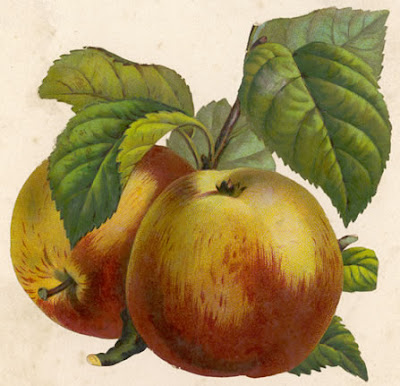

A repost with updates
A highly subjective sampling of some of the more intriguing names
bestowed on the apple:
Red Astrachan, Beautiful Arcade, Bigg's Nonsuch, Bismark, Bottle Green, Bramley's Seedling,
Bulmer's Norman, Calville Rouge d'Automne, Chisel Jersey, Cockagee, Coe's Golden Drop,
Cole's Quince, Cox's Orange Pippin,
Devonshire Quarrenden, Doctor Matthews, Dolgo Crab, Double Red Jonathan,
Edith Smith, Egremont Russet, Ellison's Orange, Esopus Spitzenburg, Etter's Gold,
Five Crown Pippin, Fortune, Foxwhelp, Frauen Rotacher,
Geeveston Fanny, Gravenstein, Gray Stark, Green Sweet,
Horneburger Pancake, Horse, Hubbardston Nonesuch,
Idaho Spur, July Red,
Keswick Codlin, Kidd's Orange Red, Kirk's Scarlet Admirable, Knobbed Russet,
Lamb Abbey Pearmain, Lehigh Greening, Lombart's Calville, Lydia's Red Gala,
Mincham's crab,
Newell's Late Orange, Newton's Wonder, Old Nonpareil, Perrine Transparent, Plum Crabbie,
Queen Cox,
Red Royal Limbertwig, Rubinola, Runkel,Saint Germain, Striped Beefing, Sullenworth Rennet,
Tompkin's King, Tydeman's Late Orange,
Virginia Greening,
Walter Pease, Watkin's Large Dumpling, Wealthy, Winterstein, Yellow Tremlett’s, York Imperial,
Zabergau Reinette
Codling An immature or green apple. Pippin A seedling apple. From the old French 'pepin' meaning seed. Russet The word means red, but the term here refers to the texture of the apple skins–from 'russet coat' the dull red/brown wool coats of peasants.
costermonger– In Britain, a street seller of fruit and vegetables, originally from "costard seller." Costard, which was a family of large British cooking apples popular as far back as the 13th century, became a slang term for 'head' by Shakespeare's time.
Apples of Sodom was a term I'd never heard before. The fruit of trees reputed to grow on the shores of the Dead Sea which, while lovely on the outside, are full of ashes within. Josephus, Strabo, and Tacitus evidently refer to them. Like an apple of Sodom signifies disappointment and disillusion.
Images from NYPL Digital Gallery and Mary Evans Picture Library































